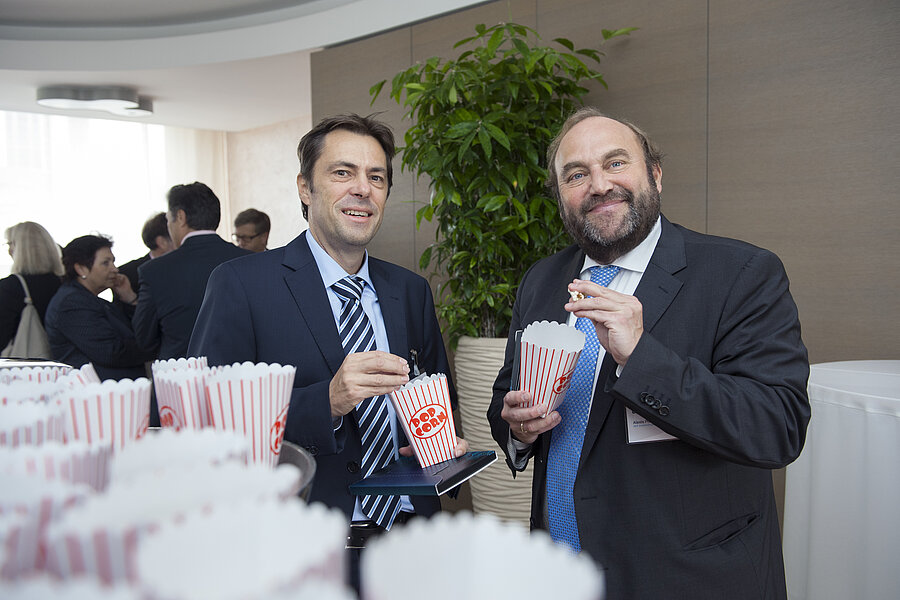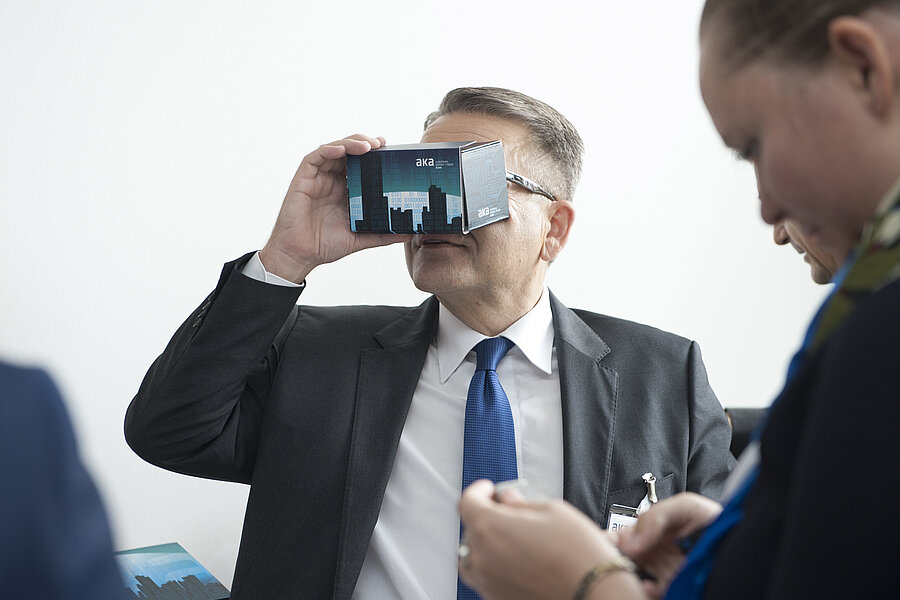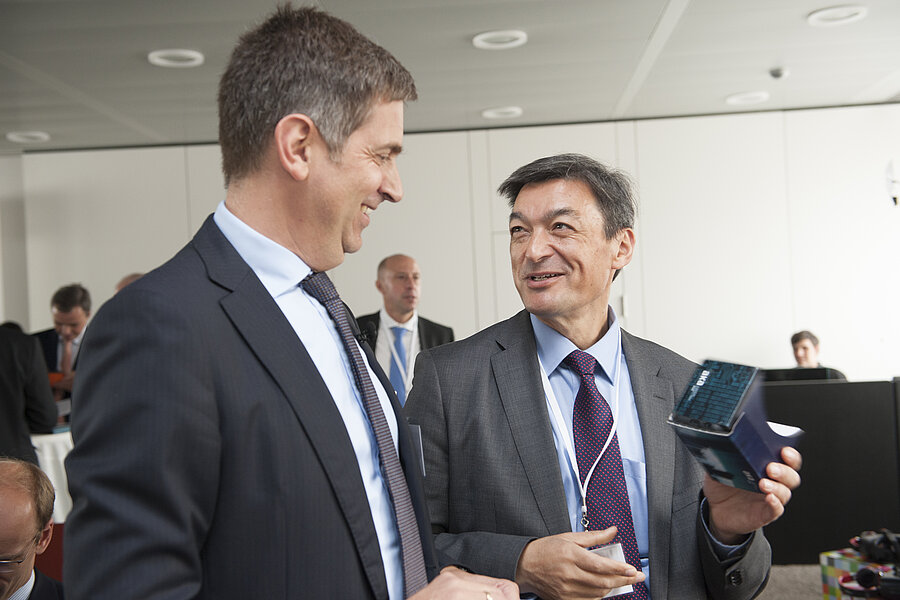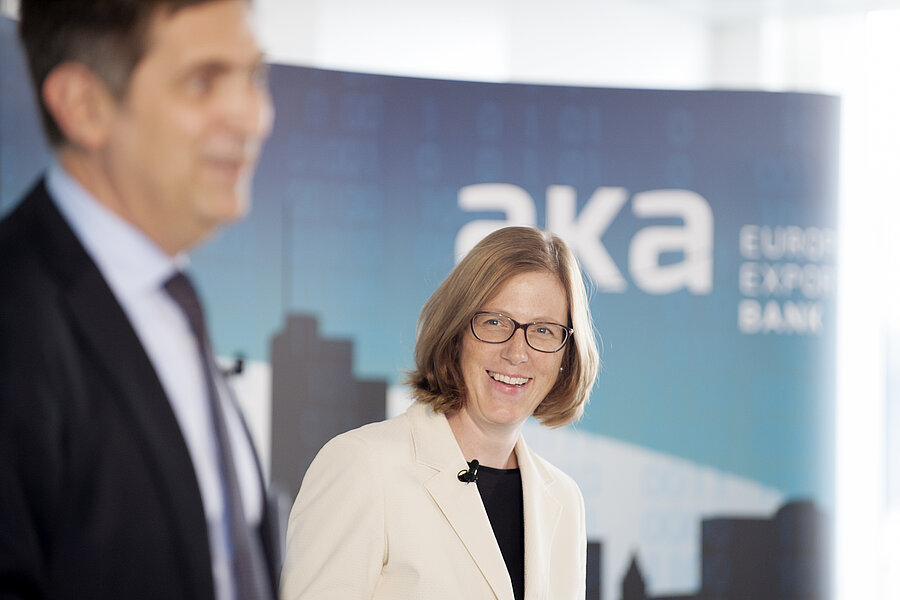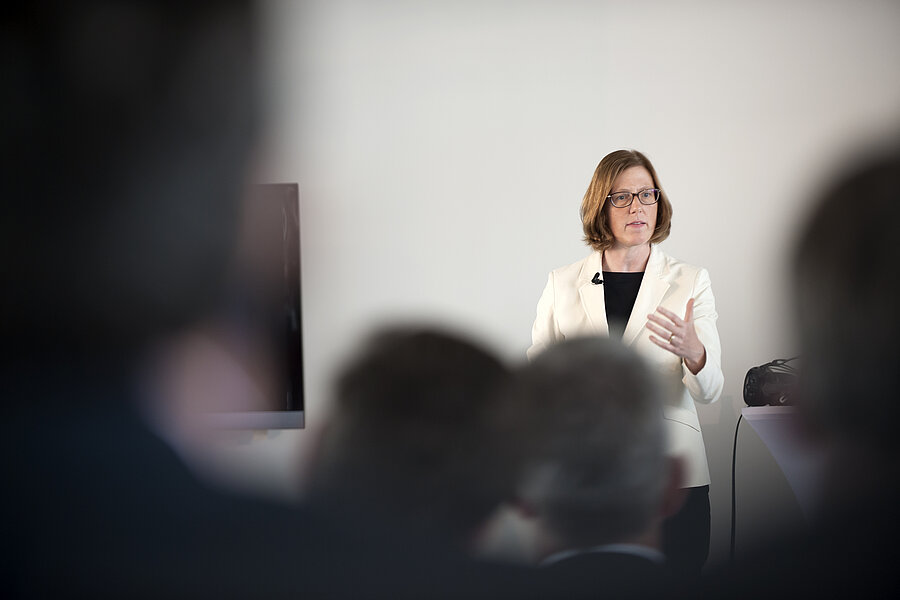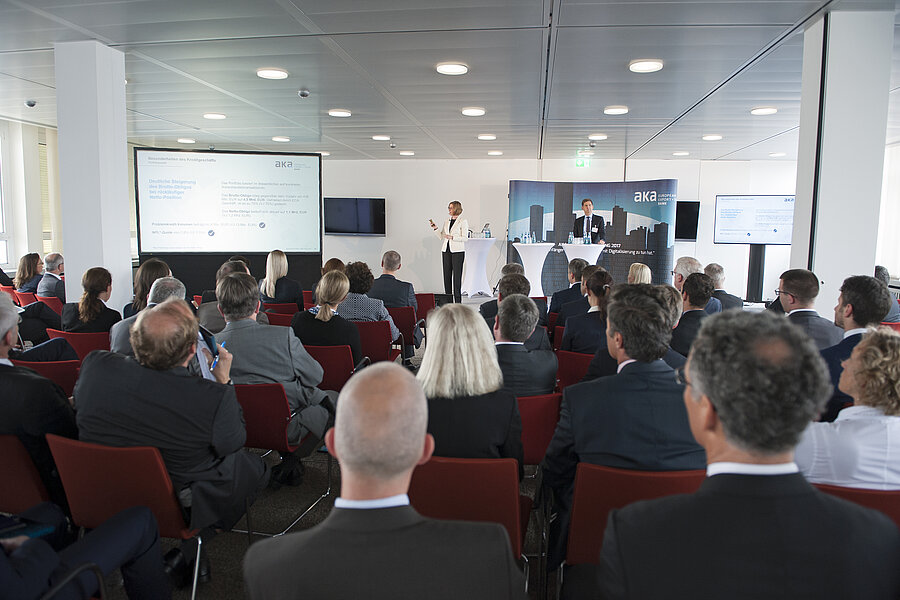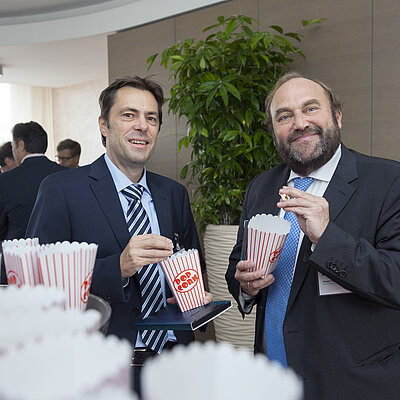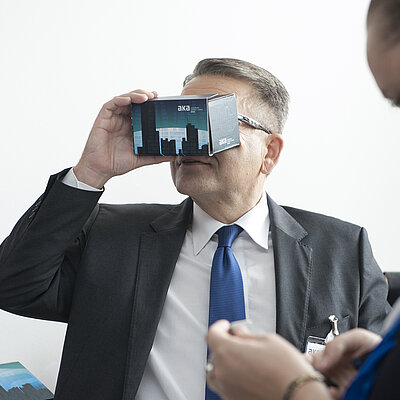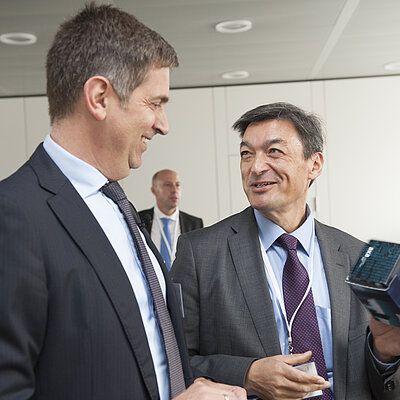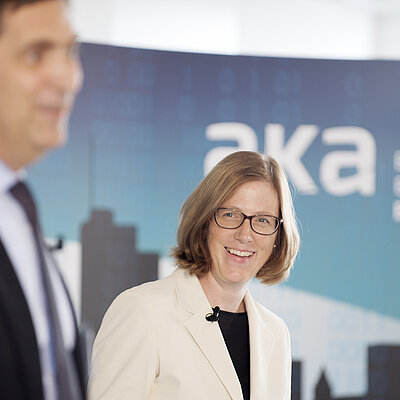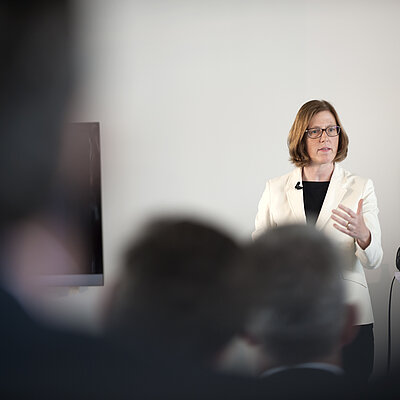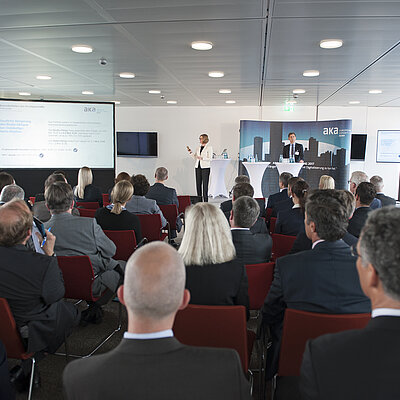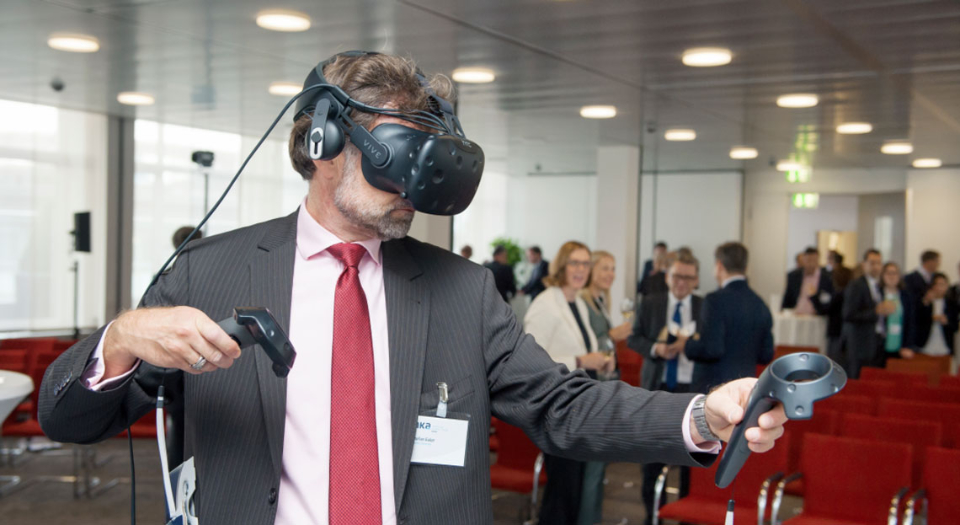
AKA Investors' Meeting 2017
The future for beginners or: what popcorn has to do with digitisation.
On 14 September 2017, AKA welcomed 90 guests to its annual Investors’ Meeting for an update on the background to the bank’s first-half figures and to discuss the potential offered by virtual worlds. The topic for the day was “The future for beginners or: what popcorn has to do with digitisation”. It was moderated by Andreas Scholz, Managing Director of Maleki Communications Group, a long-standing TV business reporter and the editor of International Bankers Forum. While munching on fresh popcorn, the participants listened to AKA Executive Directors Beate Bischoff and Marck Wengrzik, who started the day off by outlining AKA’s figures for the first half of 2017 with a particular focus on the performance of the bank’s treasury activities.
“Core business growing against the trend”
The performance of AKA’s core products painted a mixed picture: growth in syndicated trade loans over the previous year, flat structured finance business and a slight decline in FI desk business, while ECA-covered finance stood out from the rest. Although the quarterly figures were down on the previous year, reservations had reached a record level, prompting a very upbeat outlook for the rest of the year. Consequently, AKA’s core business as a whole asserted itself well despite the challenging market conditions, with the projected growth bucking the trend.
According to the forecast, gross profit and the cost-income ratio looked set to remain stable at the end of 2017.
“Strong funding = opportunities for growth in core business”
The investor base was broadened in treasury business, with international investors, for example, being tapped as a new source of funding. The challenge announced last year of engaging in additional USD funding and the expansion of existing possibilities, was not only addressed but fully executed. To give an example, the budget with long-term fixed deposits and loan notes worth up to roughly EUR 100 million and with a 5-year term was achieved with 12 tickets and terms of up to 6 years.
You can download the AKA presentation here.
Keynote “The future of virtual reality”
Prof. Dr. Frank Steinicke, University of Hamburg
After the presentation of AKA’s figures for the first half of the year, Prof. Dr. Frank Steinicke from the University of Hamburg, who teaches human/computer interaction, outlined the digital trends of the future. His presentation particularly concentrated on virtual reality. “The next generation will be ‘immersive natives’ growing up in a world in which there is no longer any difference between virtual and real objects. Wearing contact lenses, they will experience digital reality as a new form of their own reality,” explained Steinicke.
As far as the finance industry is concerned, he particularly sees potential for virtual reality in meetings and events. Virtual training will also be possible and the sharing of data will also benefit. Despite these visions for the future, networking in the real world will continue to play an important role, with VR supplementing rather than replacing these live meetings, according to Steinicke.
Prof. Dr. Steinicke’s presentation can be found here.
Discussion on “The future for beginners or: what popcorn has to do with digitisation”
Moderation: Andreas Scholz
After the theoretical introduction to this subject, Andreas Scholz asked two presenters to come up onto the stage to outline further aspects of digitisation. They broadened the perspective from virtual reality to artificial intelligence and beyond, touching on such matters as evolutionary and revolutionary changes in the German economy and the financial industry in particular: Sascha Demgensky, a lawyer and auditor and chief digital officer at PricewaterhouseCoopers Legal AG, and Axel Apfelbacher, a corporate finance advisor und digital banking strategist.
„From the real world to the virtual world and back again. I found this year’s Investors’ Meeting particularly illuminating. This analogue annual meeting is a very special event. A meeting with a future.“
Andreas Scholz, moderator
“What are the consequences of machines offering solutions which we as humans can no longer understand and, hence, verify?”
The digital transformation is a secular trend from which no one can escape. Sascha Demgenksy has found an apt metaphor for this discussion: trying to escape the ongoing digital transformation is like trying to turn right or left in a rowing boat on the Gulf stream. No matter how much the rower exerts himself, he will inevitably end up off the coast of Norway. The greatest problem arising from the digital transformation is need to create and preserve trust without returning to the analogue world. According to Demgensky, the first and so far only method of achieving this is Blockchain, which can create trust on a solely digital basis. Further information on Blockchain, which was discussed at last year’s Investors’ Meeting, can be found here.
Returning to the title story of the day, Sascha Demgensky said: “What the digital transformation and earthquakes have in common is that it is easy to predict the occurrence of further major events but difficult to say when they will actually occur.” We must all live with this uncertainty as well as the comprehensive change in the economy and society caused by digitisation. Says Axel Apfelbacher: “This exponential development initially looks like a linear process but will unleash enormous changes in our lives within a short space of time. Germany is lagging behind in this development massively and we need a far greater awareness across the entire country of these changes and a willingness to play an active role.” Returning to the question of trust mentioned by Sascha Demgensky, Apfelbacher went on to say that the major themes of trust, identity and money were still backed by processes firmly rooted in the analogue world. They thus stand in stark contrast to what digitisation actually means.
One example is our analogue legal system and understanding, where two worlds are colliding. As he sees it, the key question facing us in the future is this: “What happens when machines offer solutions that we can no longer understand?”
“Is something there? No, we still have time.”
In conclusion, Andreas Scholz asked for a run-down of the major changes expected in the near future: Apfelbacher sees the end of the automotive industry in Germany in its current form once the self-driving car arrives as this will trigger a massive decline in the number of cars sold, leading to the collapse of all logistic chains. However, it is anyone’s guess when this will happen. Adds Demgemsky: “Here as well, we know that it will happen but not when.” He mentioned a phenomenon in which people tend not to notice the individual stages of technological development.
In this way, he returned to the day’s motto: What has popcorn got to do with digitisation? When we make popcorn, we first place a pan of oil and corn on the stove and wait for the oil to become hot. For a long time, nothing happens. Then the first corn goes “pop”. “What was that?” we ask, coming to the conclusion that we still have plenty of time. Then further corn starts popping in ever shorter intervals and the pan quickly becomes filled with popcorn. This is an apt metaphor for the digital transformation.
A practical test of virtual reality
After all the theory with visions and forecasts for future, it was time for a practical hands-on session at the end of the event. ThreeDee from Munich presented augmented and virtual reality equipment, showing what it is already capable of. A specialist in high-end 3D visualisation, the company develops interactive applications for smartphones, tablets, PCs and web browsers in a wide range of different areas and sectors, including health care and architecture as well as retail, sports and mechanical engineering. Managing director Philip Balonier and chief developer Andreas Malhofer had brought various virtual reality glasses with them.
First of all, Andreas Scholz tested the HTC Vive glasses and an application by ThreeDee GmbH, which allows doctors to measure blood pressure and perform injections in a virtual surgery all in an incredibly real design. After this live demonstration of the latest technology, all the guests were invited to try out the glasses themselves. In addition to the HTC Vive, they were also able to try the Samsung Gear for mobile applications.
Closing get-together
In addition to sweet or salty fresh popcorn, the rest of the buffet was also related to the motto of the Investors’ Meeting. Japan is at the cutting edge of virtual reality. Many young people living there already move in a predominantly virtual reality, no longer leaving their homes for shopping, sports or meeting friends. They now do all of this on a solely virtual basis. This was reflected in the Asian finger food and beverages offered during the get-together. As in every year, AKA thus provided a forum for exchange among banks.
Image gallery
